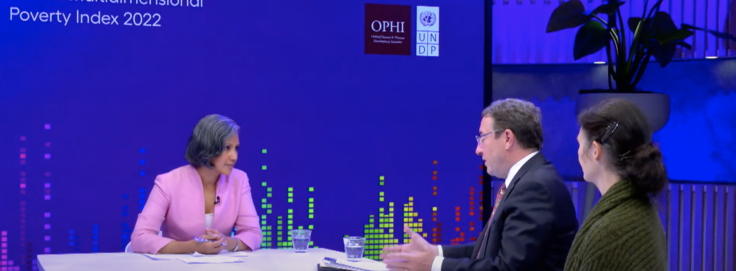
Search
Smart data and targeted interventions – speakers discuss deprivation bundles to inform integrated policies at 2022 global MPI launch

18 October 2022 – The annual update of the global Multidimensional Poverty Index took place on the International Day for the Eradication of Poverty with the live online launch event of the report: Global Multidimensional Poverty Index 2022: Unpacking deprivation bundles to reduce multidimensional poverty.
The 2022 global MPI compares acute multidimensional poverty for 111 countries in developing regions. These countries are home to 6.1 billion people, three-quarters of the world’s population. Of these people, the report finds that 1.2 billion (19.1%) are identified as multidimensionally poor.
This year’s report, produced and launched by the Oxford Poverty and Human Development Initiative and the United Nations Development Programme Human Development Report Office (UNDP HDRO), examines interlinkages, or the simultaneous interlinked deprivations which multidimensionally poor people face around the world.
The report presents the first in-depth global analysis of the possible combinations – or bundles – of deprivations across the ten indicators measured in the global MPI.
At the launch event, UNDP Administrator, Achim Steiner, described these deprivation bundles as ‘entry points’ for policy makers and called on governments to make use of smart data to inform targeted interventions that can act as an antidote against future catastrophes.
OPHI Director, Sabina Alkire, recalled the words of Amartya Sen on how we must not become inured to ‘the calamity of poverty’ and discussed how the numbers of 1.2 billion poor should challenge us into action, citing how this year’s report on interlinkages offers advances that governments and agencies can use to address poverty.
Tasneem Mirza, Research Specialist of the Human Development Report Office, described how this year’s analysis investigates which deprivation bundles are most frequent, and observed that half of the poor (593 million) are deprived in both electricity and clean cooking fuel, making clean energy a pivotal area for intervention.
Strikingly, Sabina Alkire confirmed that the joint analysis showed ‘there is no magic bundle’ to address poverty, ‘one has to go country by country and group by group’ to make sense of the lived experience of poverty to plan integrated responses.
The updated results for the 1.2 billion people who live in multidimensional poverty across the world were shared. Children represent half of the multidimensionally poor worldwide, overrepresented with 1 in 3 children across 6.1 billion people being poor as opposed to 1 in 7 adults. All speakers recognised the long-lasting impact of poverty on children. Dr Hala Helmy el-Said, Minister of Planning and Economic Development in Egypt, gave the example of the Decent Life Initiative, which addresses all dimensions of Egypt’s draft national MPI, and was augmented in 2021 to have greater reach into rural areas.
Dr Aminata Touré, former Prime Minister of Senegal, highlighted the need to invest in young people but also specifically women’s empowerment. Luis Felipe López-Calva, Global Director of Poverty and Equity Global Practice, at the World Bank reflected on inequality, noting we must strive for inclusive growth ‘There are no markets to deal with some of the specific dimensions of poverty’, he said, governments must step in and lift the constraints ‘so those at the bottom of the distribution can participate more proactively in the growth process and achieve more inclusive growth.’ In discussing child poverty, Achim Steiner had sounded a similar note when he argued that ‘Governments need to correct for what is not just a market failure but a policy failure’.
Poverty reduction trends in 81 countries were highlighted, and speaker Aminata Touré, former Prime Minister of Senegal noted that she was encouraged to see that of the 20 countries that reduced their MPI value the fastest, 12 were in Sub-Saharan Africa.
In 2020, the global MPI report simulated that the pandemic had set poverty reduction back by 3–10 years. At the launch, Sabina Alkire shared that updated data indicate that the setback at the global level is likely to be on the high end of those projections. The OPHI Director also pointed out that data are not available to permit the global MPI to reflect the post-pandemic situation and highlighted the call from this year’s report to focus on data collection as well as the importance of frequent household surveys to capture the impacts of shocks and mark progress.
Most optimistically, the report highlights pre-pandemic trends over 15 years in India, where the number of poor people dropped by about 415 million with the poorest states and groups, including children, showing the strongest absolute reductions in poverty. India’s journey demonstrates that the SDG goal of ‘reducing at least by half the proportion of men, women and children of all ages living in poverty in all its dimensions according to national definitions by 2030’ is achievable. For this reason and following the sharing of targeted policies at the event, UNDP Administrator, Achim Steiner closed the launch by saying that ‘this report is about hope if you take the issues seriously’.
Watch recording of the live launch
Explore OPHI resources on the global MPI
UNDP HDRO resources on the global MPI
Press release for the global MPI 2022 (English)
Press release for the global MPI 2022 (Spanish)
















